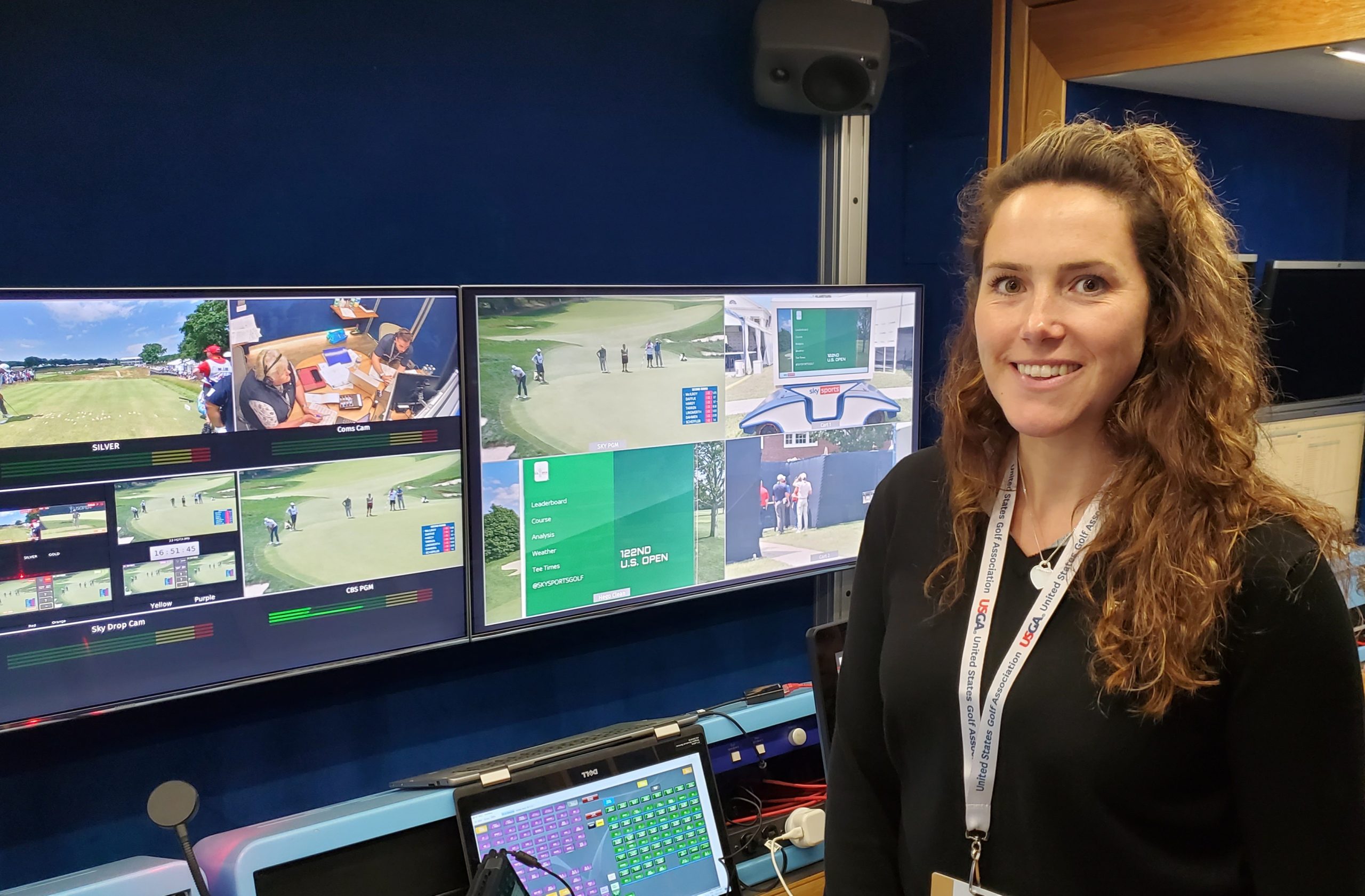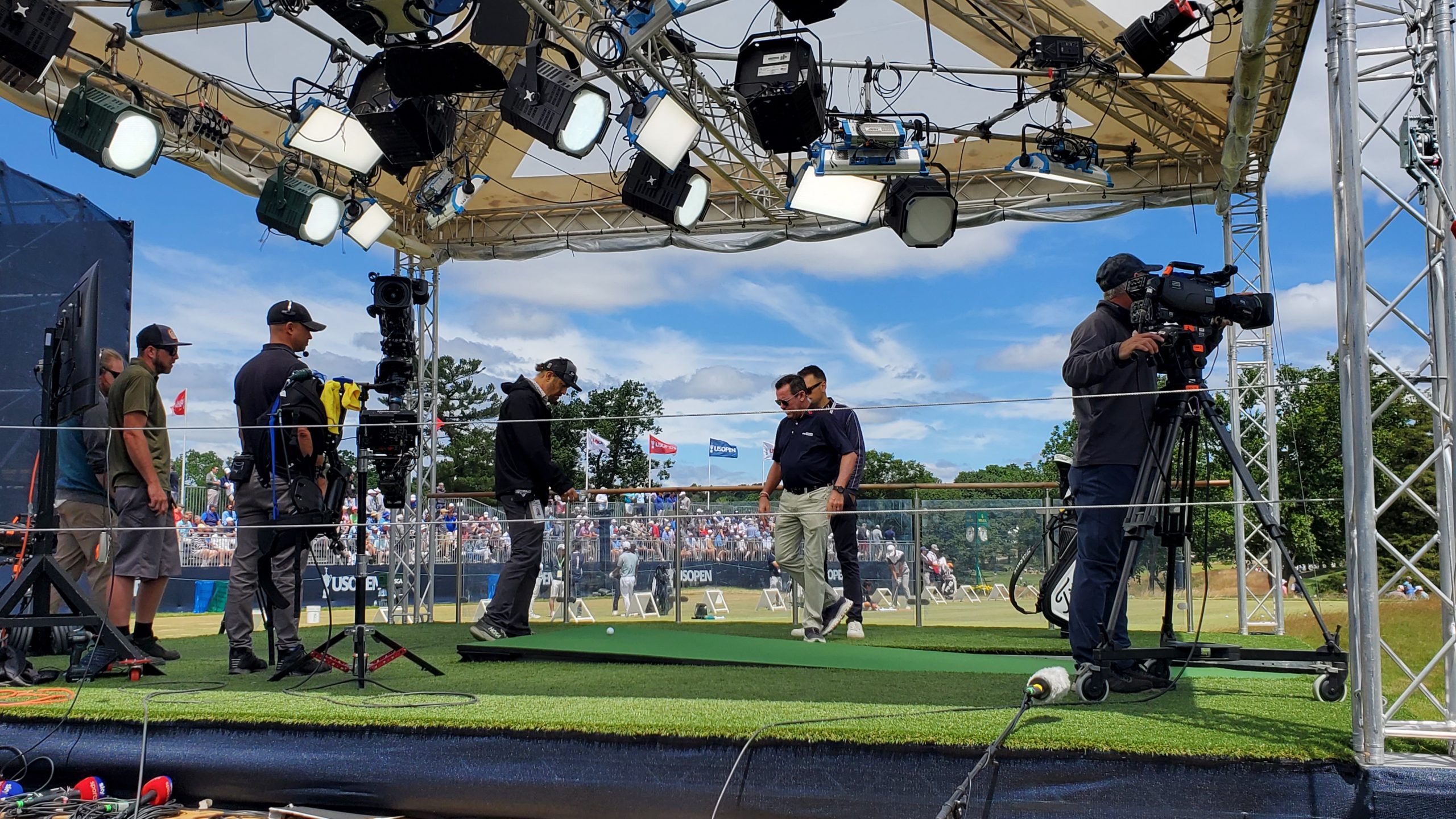Live From the U.S. Open: Sky Sports’ Katie Harrison, Jason Wessely Discuss Evolution of Remote Production
On-site Team Serves Up Feeds to Production Gallery Back in London
Story Highlights
The Sky Sports production team for the U.S. Open Championship is back on site in a big way with a team of 35 covering all the action and using the Telegenic TWiz OB as a launch point for 36 camera feeds that are sent to a production gallery in London where the final product is cut and distributed to UK viewers.
“We did the Ryder Cup [last fall] in a very similar way to how we’re doing the U.S. Open this week,” says Katie Harrison, Sky Sports Golf production manager. “Here in TWiz we have a Simply Live system and an assistant producer back at Sky can choose which 36 feeds and camera angles they want to use for the program cut.”
Jason Wessely, Sky Sports Golf executive producer, says the pandemic required a pivot to where up to 90% of the operations were done remotely, thousands of miles away from the PGA TOUR and Major event locations. Last year’s coverage from Torrey Pines, for example, only had a handful of talent and engineers on site. This year there are 35 crew on site, working closely with a similarly sized team back in London.
“During that time, we learned how to be far more efficient and effective with a hybrid remote system, which is where we’ve sort of gravitated towards now,” he says. “Right now, the heavy lifting is done in the galleries back at Sky.”
Sky has a dedicated production gallery, PCR 33, for golf but the size and scale of the U.S. Open production requires one of the Sky main English Premier League football galleries.
“It has a lot more capability as we are sending a lot more feeds back,” says Harrison. “It gives us a bigger engine so we can do more than we can with the regular golf gallery.”
The Sky team back in London works with the NBC feed and then cuts in shots of UK golfers to give fans back home a chance to see as many shots as possible from their favorite golfers.
“It’s very fast paced as the team constantly cuts in and out of the NBC network feed,” says Wessely. “But it gives the UK a localized product.”
Harrison says she works closely with the NBC production and technical team to get a copy of the camera list so that the Sky producer and assistant producer can figure out which 48 feeds are brought into TWiz.
“The assistant producer back at Sky will discuss with our Simply Live engineer what 36 of those 48 feeds they will want to see at a given time,” she explains. “And he can change which feeds and the layout depending on current needs.”
There are also seven unilateral cameras available, including three cameras in the Sky Zone studio which is located on the range. The Sky Zone studio not only is a place to interview players but also do demonstrations of different types of shots.
“We have a TopTracer camera at the Sky Zone and also two cameras at the Sky Cart [for post-round interviews] and then we have an RF camera on the course and a camera drop on the 18th fairway,” says Harrison. “So, we’ll use that on Saturday and Sunday and give viewers the atmosphere and everything.”
Harrison says the biggest challenge with the main gallery so far away is the reliance purely on talk back and intercoms but that overtime the team has grown comfortable with being far removed from the main gallery.
“If something happens when you are all on site you can run into the truck whereas now it’s intercoms, Internet, and data connectivity,” she says. “It does work, and it has been very good but when we first started it we were all nervous. But the more we work this way the more you realize just how much can be done despite it being very different.”
Adds Wessely: “I think we do a great job with what we’re doing now. The main storytellers, the commentators, are on screen and it’s really important to have them here because they are the communicators. And the producer and the director can hear from the people that are on the ground everything else they need to know. It’s not quite 100 percent experiential as it was before but it’s pretty close.”
The Sky team is already focused on the next major: the 150th Open Championship from St. Andrews in four week’s time. Wessely says it’s going to be a huge hybrid remote production with the main gallery back at Sky.
“At St. Andrews we’ll have the Sky Zone, the Open Zone, and a separate studio as well as an alternative presentation position,” he adds. “And we’ll be collaborating with the R&A to produce a ‘Live at the Range’ feed every day of the practice range. Viewers will be able to tune in pretty much any day and at any time and see players practicing before or even cooling down after their round. And we’ll also have a couple of shows Saturday and Sunday that will appeal to a broader audience.”
Adds Harrison: “We’ll also do some on-course presentation with RF cameras and the good thing about that is we will be able to do those from many different places rather than being stuck to a particular drop. We tend to have four on-course commentators at the Open Championship.”
The U.S. Open and the Open Championship both have Sky Sports and NBC Sports heavily involved and the two entities continue to grow closer and closer together on their golf production efforts.
“We feel like we’re pretty much joined at the hip, and we know what each other are doing,” says Wessely. “Sometimes the productions go different ways because of different cultures or slightly different languages or commercial differences. But we both cover golf very comprehensively, we both have talent that we share and co-share, and then we share a little programming. They’re great to work with and we both have golf at the heart of our interests.”


